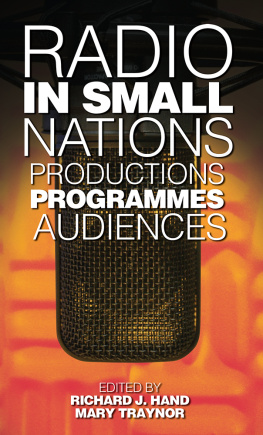Tiziano Bonini - Radio Audiences and Participation in the Age of Network Society
Here you can read online Tiziano Bonini - Radio Audiences and Participation in the Age of Network Society full text of the book (entire story) in english for free. Download pdf and epub, get meaning, cover and reviews about this ebook. year: 2014, publisher: Taylor & Francis, genre: Politics. Description of the work, (preface) as well as reviews are available. Best literature library LitArk.com created for fans of good reading and offers a wide selection of genres:
Romance novel
Science fiction
Adventure
Detective
Science
History
Home and family
Prose
Art
Politics
Computer
Non-fiction
Religion
Business
Children
Humor
Choose a favorite category and find really read worthwhile books. Enjoy immersion in the world of imagination, feel the emotions of the characters or learn something new for yourself, make an fascinating discovery.

- Book:Radio Audiences and Participation in the Age of Network Society
- Author:
- Publisher:Taylor & Francis
- Genre:
- Year:2014
- Rating:3 / 5
- Favourites:Add to favourites
- Your mark:
- 60
- 1
- 2
- 3
- 4
- 5
Radio Audiences and Participation in the Age of Network Society: summary, description and annotation
We offer to read an annotation, description, summary or preface (depends on what the author of the book "Radio Audiences and Participation in the Age of Network Society" wrote himself). If you haven't found the necessary information about the book — write in the comments, we will try to find it.
Tiziano Bonini: author's other books
Who wrote Radio Audiences and Participation in the Age of Network Society? Find out the surname, the name of the author of the book and a list of all author's works by series.
Radio Audiences and Participation in the Age of Network Society — read online for free the complete book (whole text) full work
Below is the text of the book, divided by pages. System saving the place of the last page read, allows you to conveniently read the book "Radio Audiences and Participation in the Age of Network Society" online for free, without having to search again every time where you left off. Put a bookmark, and you can go to the page where you finished reading at any time.
Font size:
Interval:
Bookmark:

Series Advisory Board: Denis McQuail, Robert Picard and Jan Servaes
 | Published in association with the European Communication Research and Education Association (ECREA), books in the series make a major contribution to the theory, research, practice and/or policy literature. They are European in scope and represent a diversity of perspectives. Book proposals are refereed. |
| 1 | Audience Transformations Shifting Audience Positions in Late Modernity Edited by Nico Carpentier, Kim Christian Schrder and Lawrie Hallett |
| 2 | Audience Research Methodologies Between Innovation and Consolidation Edited by Geoffroy Patriarche, Helena Bilandzic, Jakob Linaa Jensen and Jelena Jurii |
| 3 | Multiplayer The Social Aspects of Digital Gaming Edited by Thorsten Quandt and Sonja Krger |
| 4 | Mapping Foreign Correspondence in Europe Edited by Georgios Terzis |
| 5 | Revitalising Audience Research Innovations in European Audience Research Edited by Frauke Zeller, Cristina Ponte and Brian ONeill |
| 6 | Radio Audiences and Participation in the Age of Network Society Edited by Tiziano Bonini and Beln Moncls |
by Routledge
711 Third Avenue, New York, NY 10017
2 Park Square, Milton Park, Abingdon, Oxon OX14 4RN
Radio audiences and participation in the age of network society / edited by
Europe. I. Bonini, Tiziano. II. Moncls, Beln, 1974
ISBN: 978-1-315-81519-0 (ebk)
by Apex CoVantage, LLC
To Herminia and Ricard
Hang the blessed DJ
Because the music that they constantly play
It says nothing to me about my life
(The Smiths, 1986)
Font size:
Interval:
Bookmark:
Similar books «Radio Audiences and Participation in the Age of Network Society»
Look at similar books to Radio Audiences and Participation in the Age of Network Society. We have selected literature similar in name and meaning in the hope of providing readers with more options to find new, interesting, not yet read works.
Discussion, reviews of the book Radio Audiences and Participation in the Age of Network Society and just readers' own opinions. Leave your comments, write what you think about the work, its meaning or the main characters. Specify what exactly you liked and what you didn't like, and why you think so.





